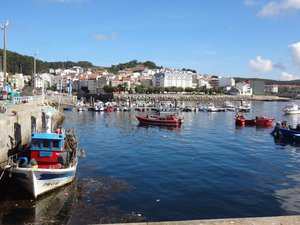Advertisement
Published: October 4th 2014

 Laxe
Laxe
One of our first days in an area known to be cold and rainy. So much for trusting the tourist guides: everything we read said that Galicia is “green Spain”, that it rains daily and that high are in the 60s this time of the year. I packed two pile shirts, a sweater, a quilted jacket and a raincoat, and nagged Tom into bringing a quilted vest and his LandsEnd jacket. All of this went into our backpacks. Well, we’ve had blue skies and temps in the 80s every day. Luckily, it’s cooled down each night, as the hotels and hostals are not air conditioned. It’s beautiful!
Notes for those planning a similar trip: First, the
Cadogan Guide: Northern Spain, published 2011, is virtually useless for traveling in Galicia. Its tone is condescending, sometimes nasty, and its traveling advice and directions are wretched. One easy example: on page 350: “Getting to and around the Ria de Vigo: By Air, By Bus and Train, By Boat.” Ummm … by car? Apparently not. In another place, the book stresses Ourense’s horrible traffic, which is no worse than the traffic in any other city, while Ourense’s beautiful Roman bridge and public spaces let us drink a glass of wine while watching children play and adults enjoy a

 Fishermen in Laxe
Fishermen in Laxe
Getting ready to go out mid-morning.beautiful evening. (The electronics scourge has not yet affected Spain.)
Second, the Michelin map for Portugal and Spain does not contain the detail needed to drive in Galicia. Enterprise Rental Car gave us a great map from Galicia tourism (
www.turgalicia.es).
We took the train from Madrid to A Coruna (or La Coruna), a harbor city with the world’s oldest continuously operating lighthouse, the Tower of Hercules, built by the Romans in the second century CE. Luckily for me, our schedule didn’t allow us to go out and walk up the 242 steps. South of A Coruna is Spain’s “Costa da Morte”, or coast of death, famous for fishing, shipwrecks and smuggling. It is made up of many fingers of land stretching out into the Atlantic with “rias” or estuaries cutting back into the land. Fishing is still a major source of income, though an oil spill in 2002 had a severe effect on the health of the sealife. The unexpected good weather was wonderful and let us see these fishing villages and beaches with sunny skies and blue water. Each town descends from the highway (a two-lane road) to the sea on steep streets that get narrower and

 Lugo: One of Ten Gates
Lugo: One of Ten Gates
Lugo is a World Heritage Site and still a vibrant city.older as you get closer to the water. At the bottom, our little rented Ibiza barely fit through the streets. We soon learned to part high and walk down.
If you follow the map, you’ll see we drove west from A Coruna and visited Malpica, Corme Porto, and Laxe on our way down to Fisterra, also called Finisterre, the end of the world. Fisterra is the traditional “most western” point of Europe, though it’s apparently not
really the western point any more. Modern measurement has found another place, though the Cadogan guidebook doesn’t say where that it. (Must look up, though I’m on the train right now!)
We spent our first night on the coast in the town of Noia, the drove on through Combarro and Sanxenxo to Vigo, which is a big city. We didn’t explore it at all, but it’s famous for being second only to Tokyo in the size of its daily fish catch. We finally drove inland to the city of Ourense.
Galicia’s coastal area is very Celtic, not Hispanic, Roman or Moorish, and exchanged cultures over the thousands of years with sailors from all along the Atlantic coast of Europe and the

 Lugo's Walls
Lugo's Walls
Tom just helped to build some small stacked-stone walls. These are 28 feet high and more than 1.2 miles long, circling the city. Pretty intimidating.British Isles. We listened to bagpipes more than once.
For those of you who share Tom’s love of seafood: shrimp, langoustas, octopus, calamares, and many kinds of fish, fish, fish! We ate tapas, which are appetizers, rather than dinners, usually sitting outdoors.
Advertisement
Tot: 0.156s; Tpl: 0.014s; cc: 9; qc: 46; dbt: 0.0555s; 1; m:domysql w:travelblog (10.17.0.13); sld: 1;
; mem: 1.2mb

 Laxe
Laxe
 Fishermen in Laxe
Fishermen in Laxe
 Lugo: One of Ten Gates
Lugo: One of Ten Gates
 Lugo's Walls
Lugo's Walls






